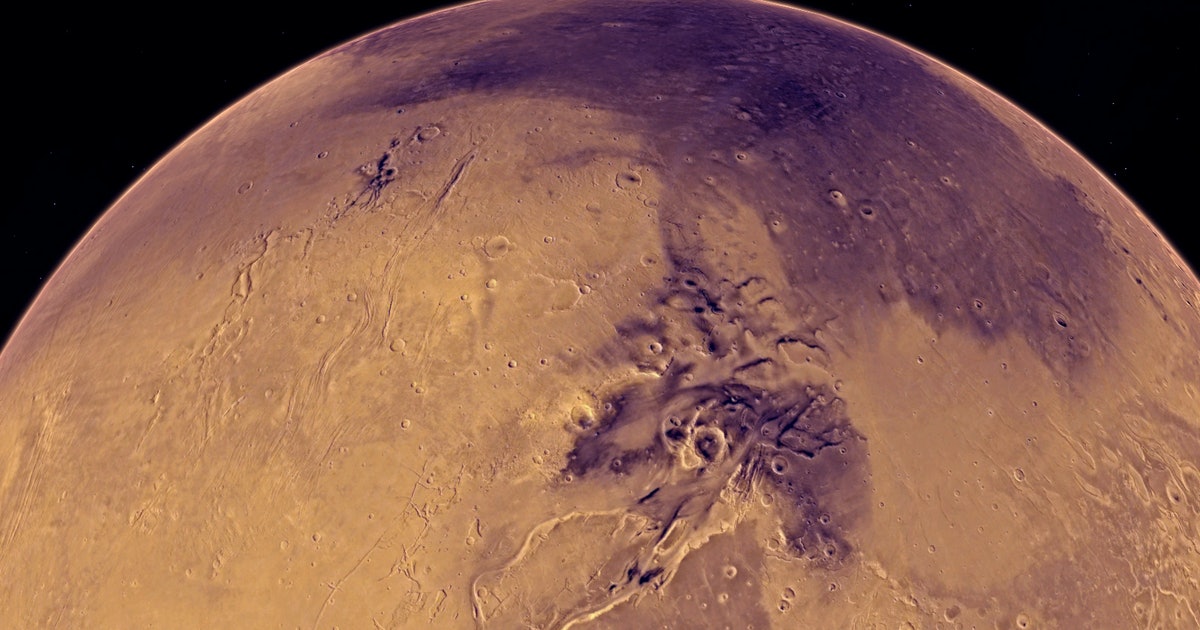
Cosmic rays could erase evidence of ancient Martian life
Cosmic rays may already have erased some evidence of ancient life on Mars, at least in most of the places scientists are currently looking. But not all hope is lost.
If chemical traces of ancient life are still buried in Martian rocks and dirt, we might have to dig deeper to find them. A recent experiment using simulated Martian regolith found that amino acids — key molecules for life, and potentially key evidence for its past existence on Mars — don’t last long on the Martian surface, even if they’re buried. The results, published in the journal Astrobiology, suggest that astrobiologists should rethink where and how they’re searching for chemical signatures of life on Mars.
What’s New — For more than a billion years, Martian dirt and rock has endured a constant bombardment of cosmic rays — high-energy particles, mostly protons and helium ions, that get blasted into space by solar flares or exploding stars. NASA astrobiologist Alexander Pavlov and his colleagues recently simulated this bombardment by zapping simulated Martian dirt samples with gamma radiation. Because gamma radiation has a similar effect to cosmic rays, but is stronger, it allowed Pavlov and his colleagues to simulate 80 million years’ worth of cosmic ray exposure in a lab experiment.
They mixed the simulated Martian dirt with molecules called amino acids. These are the molecules that form proteins, which in turn are the building blocks for most of the structures in a cell. They also create most of the enzymes that drive the chemical reactions necessary for life.
Amino aren’t unique to life; ordinary, non-living chemistry can produce hundreds of different ones. However, all living things on Earth use just 22 amino acids to build their proteins. And generally, amino acids made by living cells tend to be “left-handed.” Amino acids, like many other molecules, can come in two different forms; they’re chemically identical, but they’re mirror images of each other. Chemists have dubbed these two forms “left-” and “right-handed,” pretty much arbitrarily, and life seems to prefer left-handed (also called enantiomeric) amino acids.
“Therefore, in theory, discovery of a limited set of amino acids with strong enantiomeric excess can be a good sign of life on the ancient Mars,” Pavlov tells Inverse. “Hence, we need to understand how long amino acids can survive on Mars and what abundance of the ancient amino acids can be expected at sampling depths.”
It turns out that cosmic rays can break down amino acids even faster than scientists previously realized. In fact, it should take about 20 million years for incoming cosmic rays to destroy the amino acids in the top 10 centimeters of soil and rock — the shallow depths where most rover missions drill for samples to search for chemical signatures of life (like amino acids).
And this constant bombardment of energized particles from deep space could already have destroyed all trace of these molecules in the top two meters of Martian soil and rock.
Pavlov and his colleagues’ results suggest that rovers like Perseverance may need to dig much deeper, or look for younger outcrops of rock, to have a chance of finding chemical evidence of ancient Martian life.
Here’s the Background — Cosmic rays can penetrate several meters into solid rock, stripping electrons from the atoms they pass along the way, which turns neutral atoms into positively-charged ions. That’s called ionization, and it can break the bonds that hold atoms together to form molecules. The molecules — including amino acids — basically fall apart.
Earth’s atmosphere and magnetic field protect us from most of these particles. But Mars lost its magnetic field around 4.2 billion years ago, and most of its atmosphere about 1.5 billion years ago, leaving its surface exposed to cosmic rays.
Since then, solar flares and distant stellar explosions have been raining high-energy particles on the planet’s surface, potentially erasing chemical evidence of extinct Martian life in the process.
Why It Matters — NASA’s Perseverance Rover is currently exploring the dry remnants of a river delta. Billions of years ago, the delta was where a river emptied water and sediment from the surrounding highlands into Jezero Crater.
If places like this once teemed with life, those long-extinct organisms might have left behind not just physical fossils, but also amino acids and other molecules in sediment and rocks (amino acids are water-soluble and can end up inside rock) on Mars. By analyzing the chemical composition of rocks from the ancient riverbed, scientists hope Perseverance might find that chemical evidence.
What’s Next — Information like the results of Pavlov and his colleagues’ study can help tell scientists where to search to improve their chances of finding evidence of ancient Martian life.
Missions with shallow drill sampling have to seek recently exposed outcrops — e.g., recent microcraters with ages less than 10 million years, or the material ejected from such craters,” said Pavlov in a statement. Alternatively, future Mars missions could drill much, much deeper.
Cosmic rays could also help explain why we haven’t found anything so far, even in fairly likely places.
Dirt and rock aren’t the only places that might hold chemical traces of life on Mars. “We will be looking into survival of amino acids in ices (Martian-like permafrost),” Pavlov says.
Cosmic rays may already have erased some evidence of ancient life on Mars, at least in most of the places scientists are currently looking. But not all hope is lost. If chemical traces of ancient life are still buried in Martian rocks and dirt, we might have to dig deeper to find them. A recent…
Cosmic rays may already have erased some evidence of ancient life on Mars, at least in most of the places scientists are currently looking. But not all hope is lost. If chemical traces of ancient life are still buried in Martian rocks and dirt, we might have to dig deeper to find them. A recent…